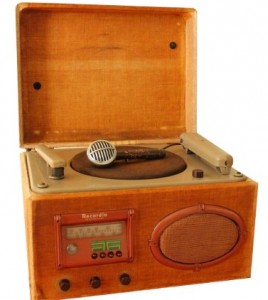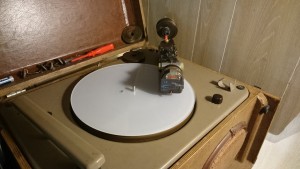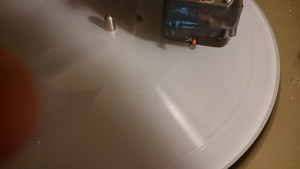Creating your own records – the holy grail of analog audio enthusiasts. In my case there’s a special advantage: I need food for my Wurlitzer jukebox. It plays 78rpm records and manufacturing of those records ended before I was born. I truly love the old music – but the selection is limited, expensive and well, at some point you might want to have more recent tunes in your machine.
You can, of course, have your own records created. There’s no app for it, but a few very professional services. But that is expensive – we’re talking 80 to a hundred dollars and it takes a few days for the record to be delivered. So – I started my very own project “Lathe”. Can’t be that complicated ..
Well – you be the judge.
 There are plenty of people who built their own lathe. While I am not inept with tools, I just don’t have the equipment to construct something from scratch – and I don’t have the money to simply buy some fancy equipment. Anyway. You need a sturdy platter to spin the record with plenty of torque and you need something that moves the cutting head slowing forward so that it can cut the track into the disk.
There are plenty of people who built their own lathe. While I am not inept with tools, I just don’t have the equipment to construct something from scratch – and I don’t have the money to simply buy some fancy equipment. Anyway. You need a sturdy platter to spin the record with plenty of torque and you need something that moves the cutting head slowing forward so that it can cut the track into the disk.
But I didn’t want to “cut” records. That requires expensive “dub” blanks (we’re talking at least 20 Dollars a pop) – I wanted to engrave or emboss “polycarbonate” – the stuff they make CDs out of.
I started with a Wilcox-Gay “Recordio” – built in the 1940s. It has two arms: A playback and a recording arm. The recording arm uses a crystal “Astatic” cutter-head and is driven by a lead screw (under the platter). The machine arrived with the cutter head dead (those crystals simply die after a few years).
I had the option to have the cutter head repaired – but I wasn’t too sure if it would produce the kind of result I was looking for. So I went ahead and purchased an old Presto cutting head which is magnetic and needs to connect to an amplifier (at the speaker connection).
After a few tries it was clear, that the Recordio’s arm has to be modified – well .. shortened to get the Presto in the correct position. That was no problem.
First try:
Everything is connected, the Presto head is wired into an old 10 Watts tube amplifier (via a 1 Amp quick blow fuse) and we start to cut. And cutting it did. Turned out the weight was way too much with almost 280 grams pushing down on the CD I was using as a test medium. The grooves looked and felt rough. The sound was “sandstorm during a bombing test run at a missile site” . No good.
Second try:
Used my finger to counter the massive weight by pushing the arm upwards while recording. Still cutting but not as bad as before. Sound changed to “sitting under a plastic roof during a rain storm in a hurricane” . Didn’t work.
… Try 14 …
I am glad I kept a few of those AOL CDs . And old games, Linux and Windows versions. They all got shredded while I was figuring out what the hell I was doing wrong.
.. Try 32 ..
Found out that the cutting arm is pulled down by a spring under the platter. I disconnected this spring and was finally able to get the record arm balanced. With another 10 or 15 tries and errors using different weights and counter weights I finally managed to go from cutting the record to embossing the record – that is what I wanted. I started to actually be able to distinguish the music from the rainstorm that was still being recorded to the polycarbonate.
… try 123 …
After I found some values for weight, volume and counter weight, I finally cut my first 10 inch polycarbonate record. Here are a few images of my construction as it is now.
And this is how it sounds in my 1937 Wurlitzer jukebox:
So – what’s next? Well – as the lead screw is directly connected to the platter motor, I am unable to modify the pitch of the cutter head. In other words: the spacing of the grooves is always the same. This is not desirable because one can’t cut lead-in or lead out grooves. So I will need to create my own linear traction system with a stepper motor connected to the sled allowing me to modify the pitch.
But there’s another problem:
The grooves embossed into the polycarbonate are shallow. Very shallow. Too shallow for my jukebox to find the lead-in. While that would be manageable, pushing the tone arm towards the trip switch at the end requires some force. But the shallow grooves just don’t offer enough traction to allow the mechanic trip the end of play. This might be a show stopper. At least for dealing for embossed polycarbonate. I may have to – at some point, promote myself to real cutting “real records”. But those “dubs” are expensive. So I continue eḿbossing my polys until I am very comfortable with the mechanics of my system and, of course, the electronics.
Stay tuned.


I just picked up the same Wilcox-Gay Recordio as you have there, a beautiful blonde. I don’t even know where to start, but I just think it’s so cool !
I’d be happy just to cut some plastic plates. I hope I can find a tech to help me a bit.